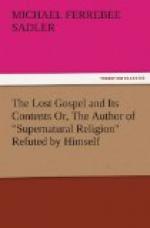But, in truth, such witnesses, whether believing or sceptical, would have found no place for their science, for the miracles of Christ were of such a kind that the most scientific doubter could have no more accounted for them than the most ignorant. The miracle of which, next to our Lord’s own Resurrection, we have the fullest evidence, is that of the feeding of the 5,000; for it is recorded by each one of the four Evangelists. Now, if this miracle had been performed in the presence of the members of all the scientific societies now in existence, their knowledge of natural laws could have contributed nothing to its detection or explanation. They could have merely laid it down to trick or deception, just as any of the unscientific persons present could have done, and perhaps did. The miracle was performed in the open. Our Lord must have been on some elevated ground where His voice could have reached some considerable part of the multitude, and on which every act of His could be observed. More than a thousand loaves would have been necessary, requiring the assistance of, say a hundred men, to collect them and bring them from a distance. This, too, is not one of those miracles which can be explained by the convenient hypothesis of a “substratum of truth.” It is either a direct exhibition of the creative power of God, or a fiction as unworthy of a moment’s serious consideration as a story in the “Arabian Nights.”
It is folly to imagine that such an act required scientific men to verify it. If the matter was either a reality, or presented that appearance of reality which the narrative implies, then the scientific person would have been stupefied, or in trembling and astonishment he would have fallen on his face like another opponent of the truth; or, may be, his very reason would have been shattered at the discovery that here before him was that very supernatural and divine Working in Whose existence he had been doing his best to persuade his fellow creatures to disbelieve.
The Scripture narratives, if they are not altogether devoid of truth, lead us to believe that our Lord performed His miracles in the face of three sects or parties of enemies, Pharisees, Sadducees, and Herodians; each one rejecting His claims on grounds of its own. They were also performed in a populous city, of which all the rulers and the mass of the inhabitants were hostile to His pretensions. Such a place could never have been chosen as the scene of a miraculous event, known by those who promulgated it to have had no foundation in truth, and withal assumed to have been known throughout the city at the time, and to have been productive of a series of results, miraculous and ordinary, which were asserted to have commenced at the moment of its occurrence.




